by Zan Raynor, certified dog trainer and CEO of ELLAS Animals INC
While training our Service Dogs in Training at home, outside, and in Public Access, I have developed a few favorite pieces of equipment for dog training. For the most part, they’re the same pieces of equipment one needs for Foundational Obedience and Tasks & Work training as well, even though I’ve included a few favorites that really only come up when working outside the house all day. I don’t receive any kickback for describing or using these products and I’ve provided links just for convenience (I don’t receive anything if anyone decides to purchase the products). I researched these and purchased them on my own. I’m not implying there are not equally or even more ideal products on the market for dog training. I’m merely highlighting a few that I personally use because I find them particularly useful for my work.

Relatively Inexpensive Equipment for Dog Training
If you’re going to train a dog, you’ll need a few basic pieces of training equipment and fortunately none of it needs to be expensive or hard to find. That’s good because the other expenses of training a Service Dog are high enough, like adopting the dog in the first place, having them spayed or neutered and a microchip placed, getting puppy and annual vaccinations as recommended by a veterinarian, buying monthly prescription preventatives against fleas/ticks/heartworm, feeding them, grooming them, and providing an endless supply of training treats.
Collars
The centerpiece of equipment for dog training is the collar. We recommend not using harnesses (which increase the instinct to pull) or flat buckle collars (as they can damage the dog’s neck and throat). Instead we recommend a good head halter or limited slip martingale. A head collar has a strap that goes around the dog’s nose and another strap that goes around the back of the dog’s head. The leash connects to a ring that hangs down from the nose strap, under the chin. When pulled, the strap tightens on the muzzle but not on the neck or throat. A limited slip martingale looks like a blend between a flat buckle collar and a chain choker. The limited slip part can be nylon or chain but it only slips to a predetermined tightness and so can’t choke the dog or damage their throat. It was designed to keep dogs from slipping out of their collars but provides useful training corrections, too, in the form of the light/quick pressure but also the sharp clinking sound of the metal snapping.
Gentle Leader head halter
We use the Gentle Leader head halter. It’s my favorite piece of equipment for dog training because it almost instantly ends leash pulling and also provides a particularly effective method for training the acquisition stages of “sit” and “down”. Our Service Dog in Training, Phin, wears it exclusively for walks and Public Access training and it gives him a flawless “heel”. It’s an excellent training tool but it can also be used as the collar for Public Access throughout his career. The dog can breathe (even when panting because we’re having a good run) and eat and drink with it on.
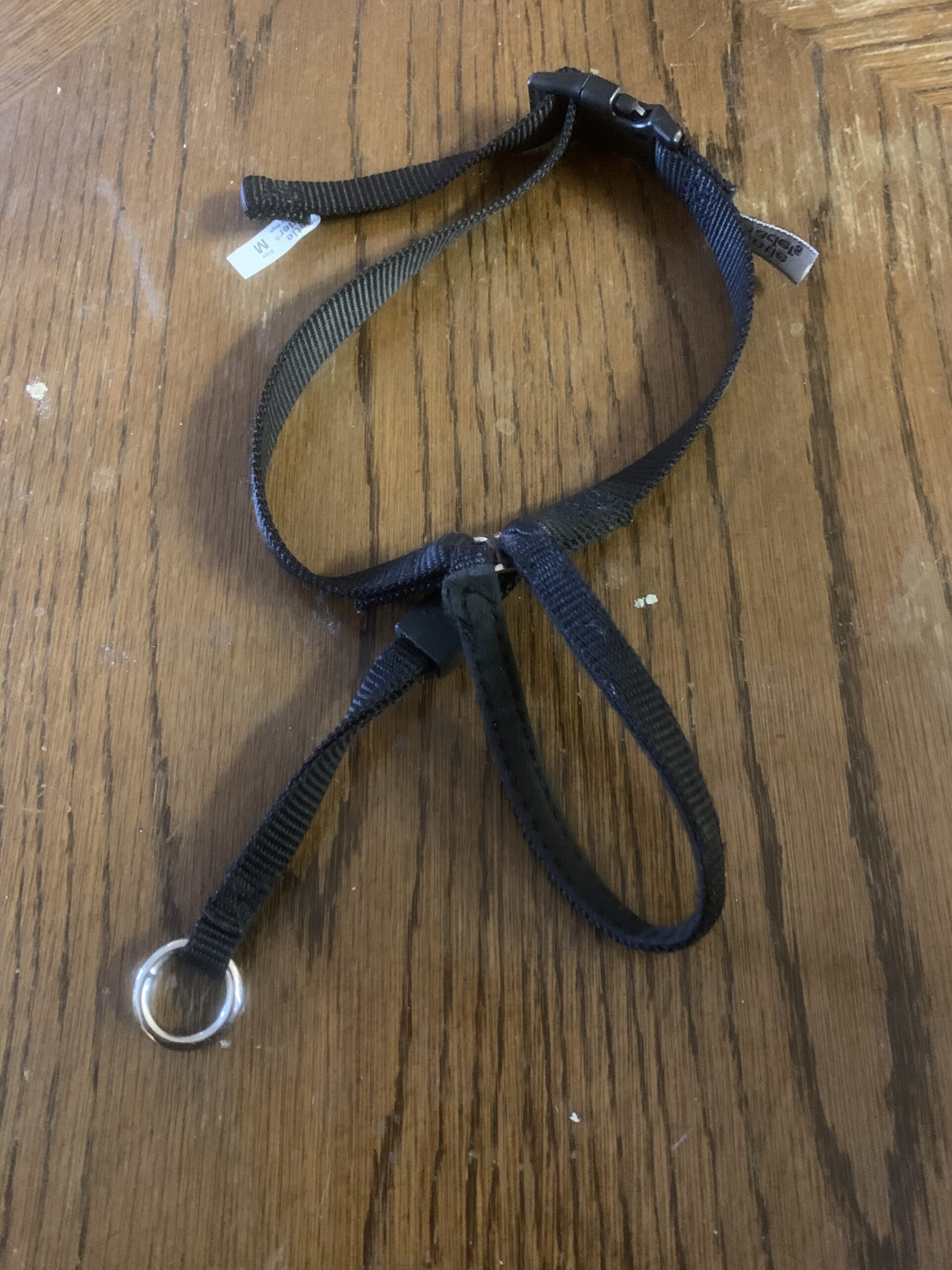

Limited Slip Martingale Collar
Our Service Dog in Training, Pumpkin, wore the Gentle Leader for a couple months during Foundational Obedience training. However, while other dogs only take a few minutes at the beginning of a few training sessions to give up their resistance to the head halter, Pumpkin (a stubborn Great Pyrenees and Australian Cattle Dog mix) never adjusted. On the advice of my trainer/mentor, we transitioned her to training with the limited slip martingale collar. I was a bit disappointed because the Gentle Leader made my job easy (it’s a very effective short cut) but I have to admit that Pumpkin relies on training now rather than the short cut, so it’s good I was pushed to this next level. I’ve got three different brands of martingales right now, as Phin wears one when we’re just working around the house or out on the boat. My favorite at the moment is Max and Neo’s, but really only because it raises my confidence with its durability and smoothness. It would be tough to chew through (but I don’t say that out loud because my dogs might construe it as a challenge) and the chain slips quickly and smoothly with an effective “clink” sound that is a correction in itself. The plastic buckle is easy to work with my hands and has a locking mechanism. The three circles or D-rings on the chain section are big and sturdy and easy to connect my leash to.
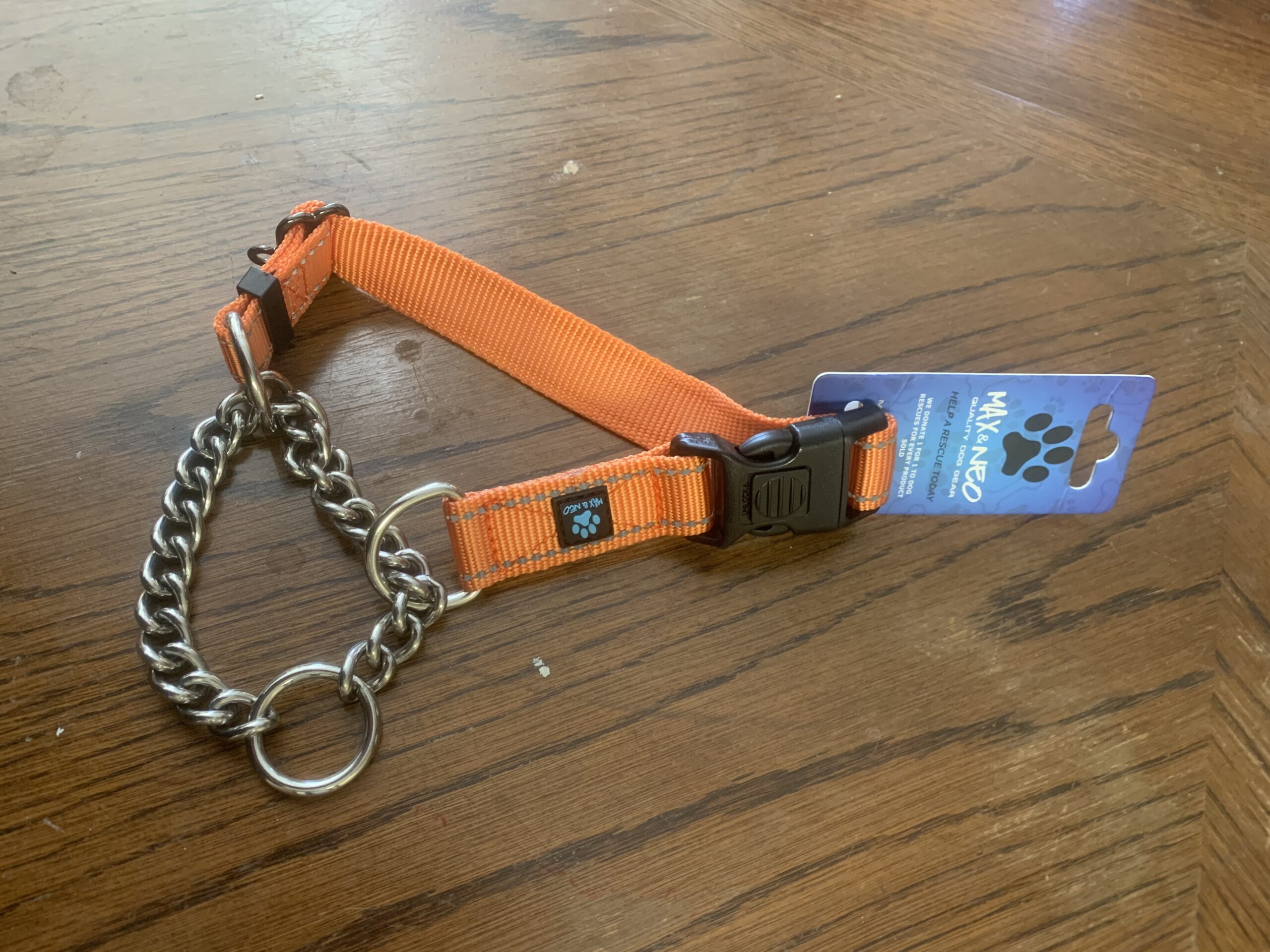
Leash
You’ll need a nice leash. Half the battle is choosing one that feels good on your hand. For training, you’ll want a 4-6 foot leash and you might consider a longer leash later as you want to work on recall and other distant tasks. Don’t use a retractable leash as they are quite dangerous for both dog and human and have no value in a training program. We prefer a leash that can secure around your waist or across your body and over the shoulder and also has a handle close to the dog’s head. Whether I put the leash around my waist or over my shoulder depends on what I’m wearing and what I’m working on, but either way I appreciate the security of knowing my dog is tethered even if I drop the handle and the freedom of having both hands free from time to time when I need it.
My current favorite leash is the Top Paw Hands-Free Comfort & Reflective Dog Leash. It’s made of strong, flat nylon but the two handles are padded, making them more comfortable on my hand. The adjustable section adjusts from merely a handle all the way to the second handle, so it can be as big as you want or need it to be. The means I can also adjust the length, even if I’m not wrapping it around myself, so I always have the right length for the skill I’m training. It’s also a really fast and easy adjustment so I change it throughout the day to suit my changing needs. I can open that section to hook it around myself so I don’t have to slip it over my head. The second handle is fixed but it happens to be positioned exactly where it needs to be for both my larger and my medium dog so I can hold it comfortably with a loose arm while the dog walks in “heel” position.
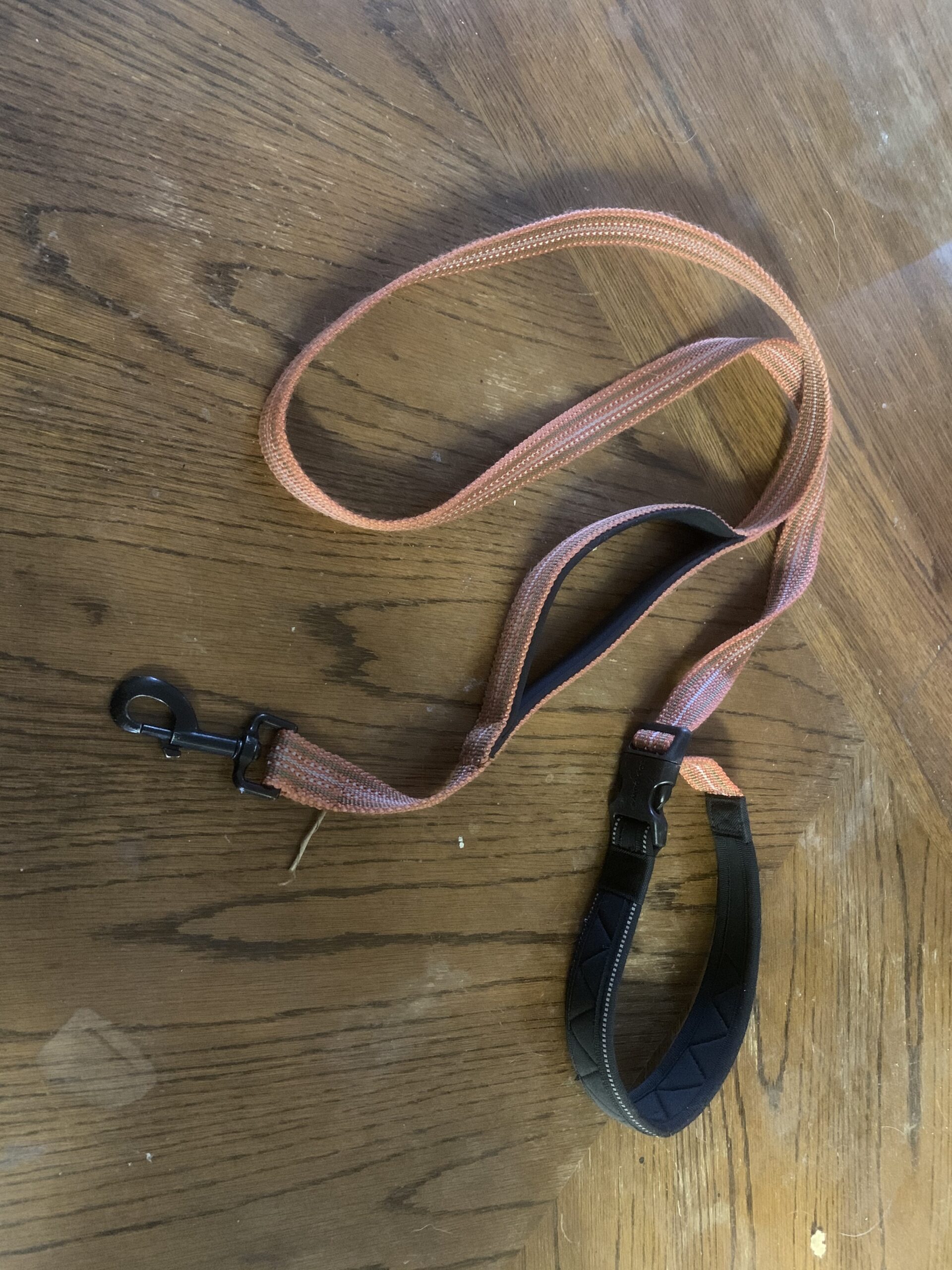

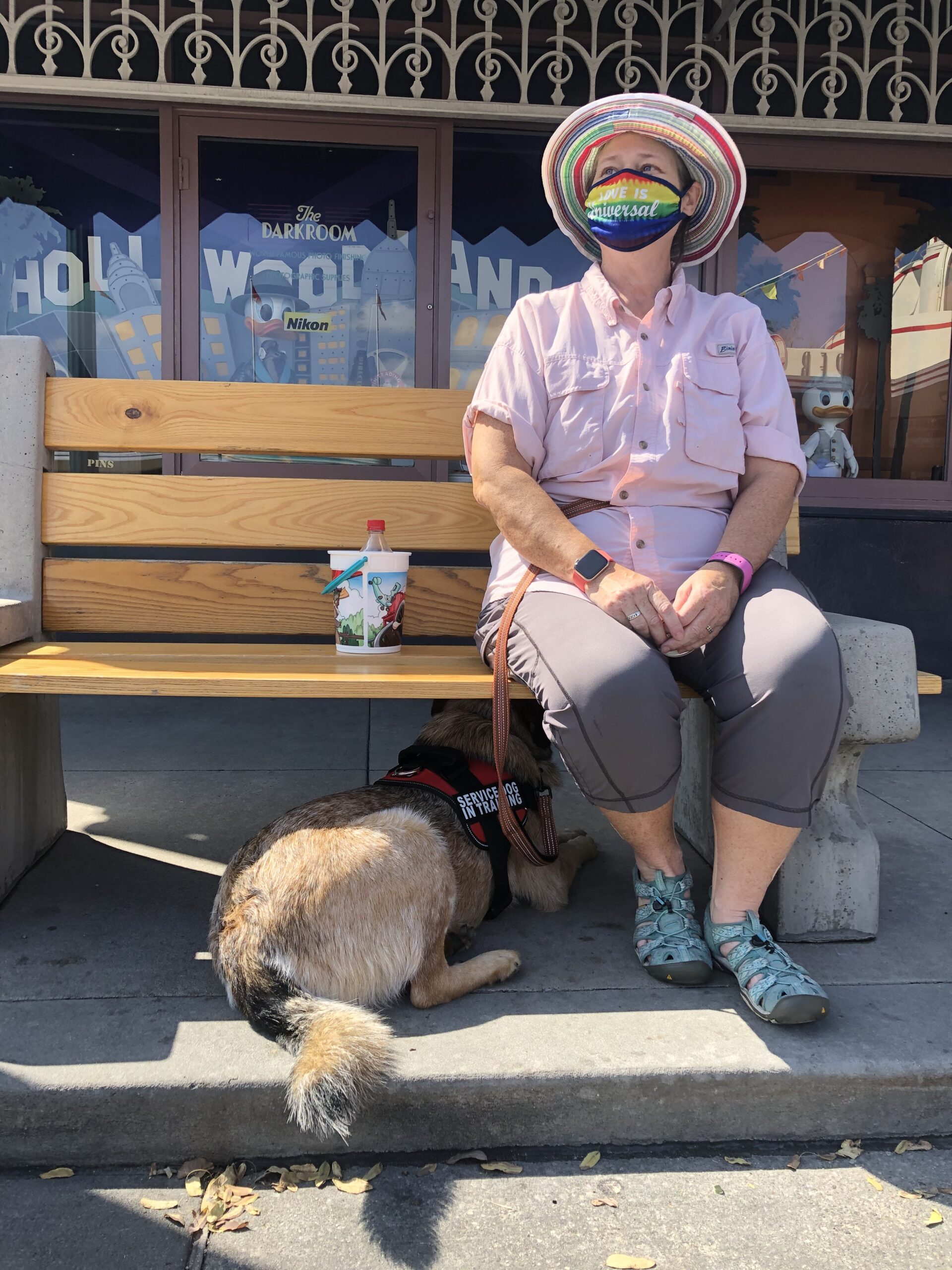
Treat Bags – Equipment for Dog Training at Home or Away from Home
Whether training at home or outside the house, you’ll want a treat bag to lug around your training treats. Sometimes I just use my pocket but I have a couple of favorite treat bags now. I have a super simple silicone one from AUDWUD that clips on a waistband or belt, goes in the dishwasher, and has a magnetic connector to keep it closed. It’s truly one-handed and so I use it every day around the house and in the yard for our formal training sessions. I don’t like it so much for Public Access training because it tends to get bumped and squished throughout a real day and then the kibble goes pouring out everywhere.
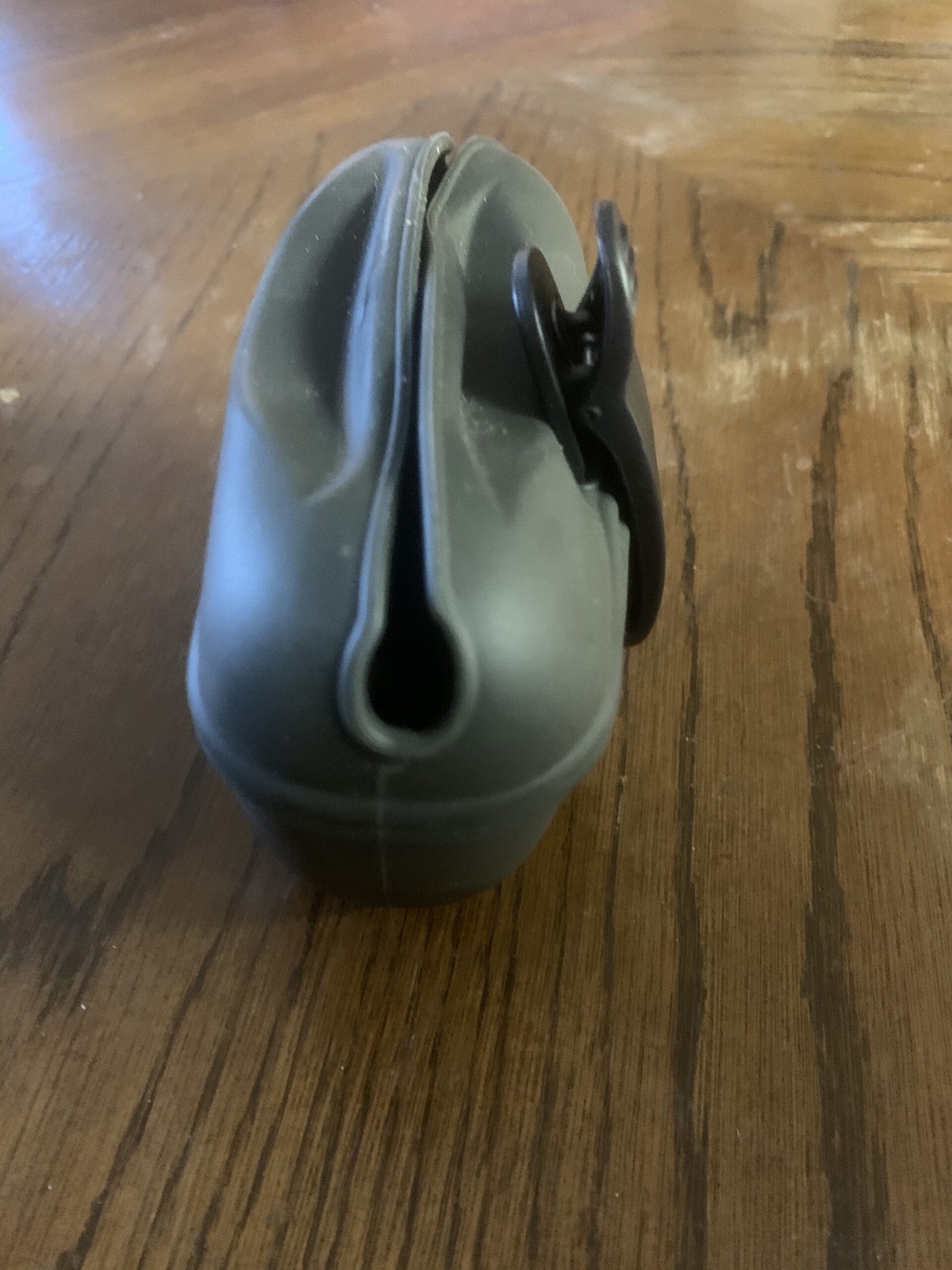
For Public Access outings, I spent a little more ($15 compared to $6 for the rubber one) getting more bells and whistles with one from Paw Lifestyles. It’s not one-handed because it has a drawstring closure, but that’s really secure and I don’t leave a trail of kibble. It also has a secret compartment for poop bags, which is convenient when I’m out for the day and never know when I’m going to need one. It also has a “private” second zipper compartment where I can store a second type of treat or business cards or wet wipes or whatever. It has a third non-private, non-zippered mesh compartment for quick access to whatever else I want to take with me. It’s convertible in that it can clip to my belt/waistband but also has a belt of its own and a shoulder strap, so I can choose each day which configuration I want based on where I’m going, what I’m doing, and what I’m wearing. Basically it’s like a very small diaper bag for taking my dogs out for the day.

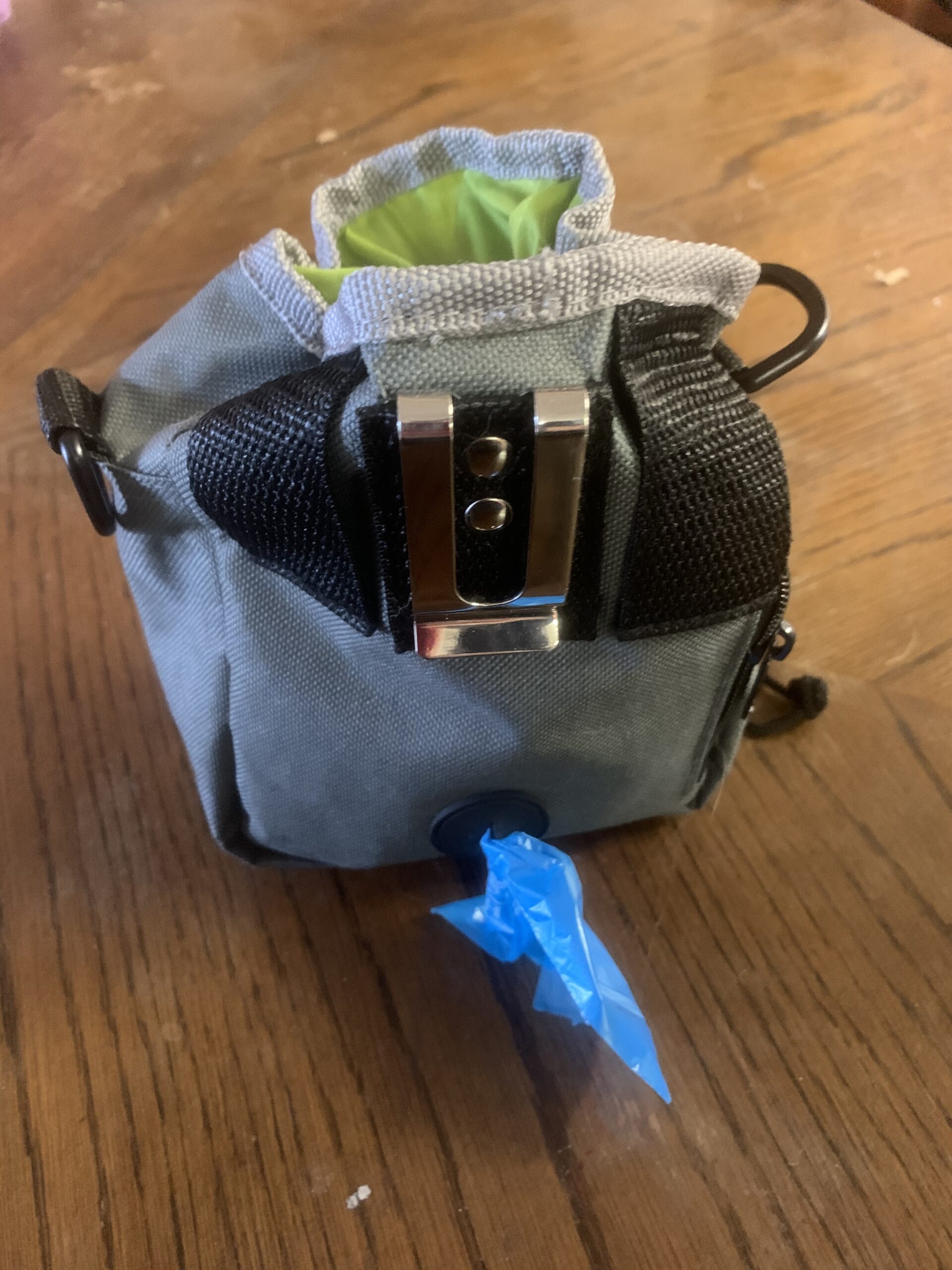
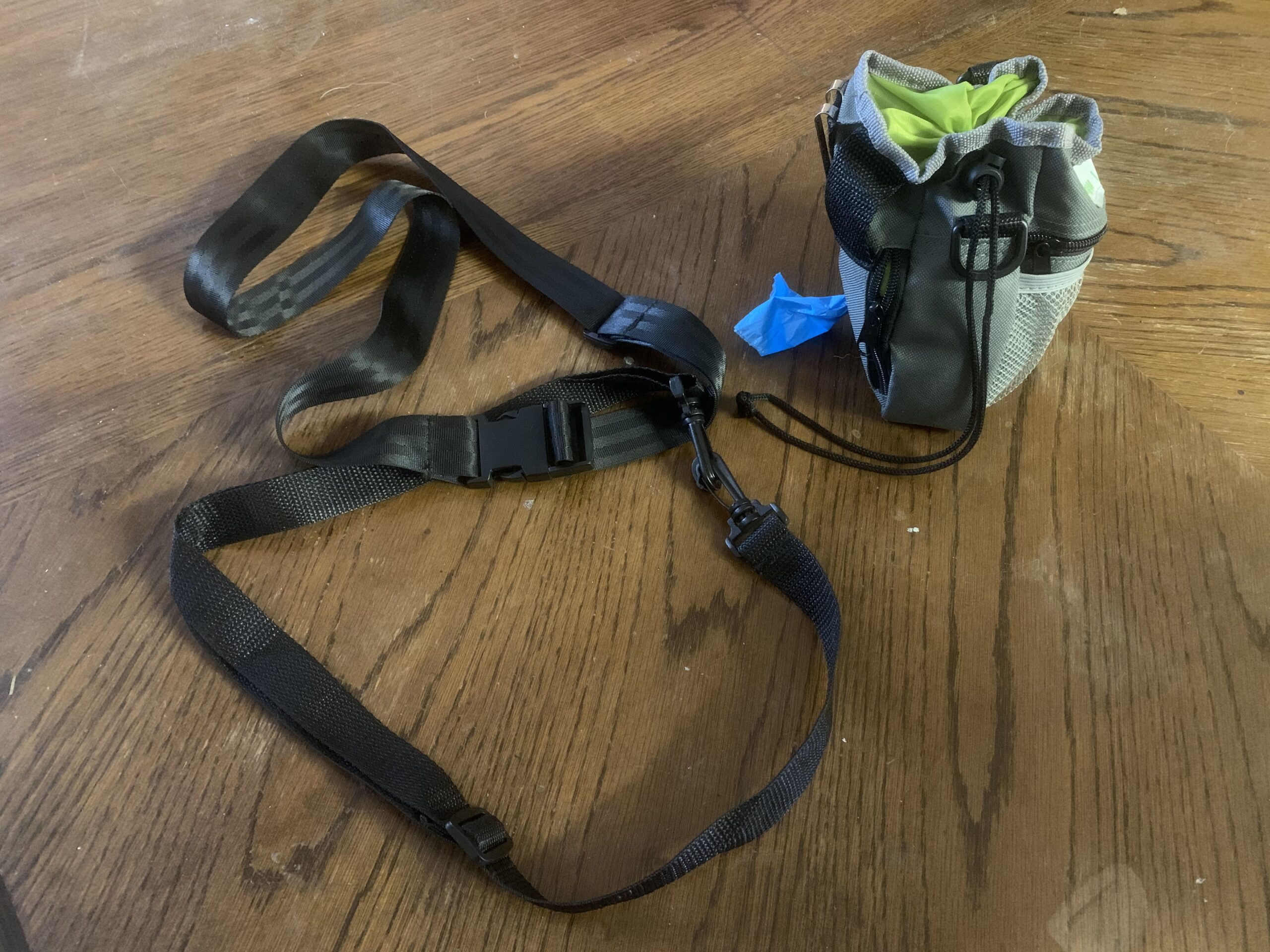
Service Dog in Training Vest – Indispensable Equipment for Dog Training
When you’re ready for Public Access training, you’ll need a Service Dog in Training vest, either harness or cape style. The choices are endless here and depend on what you want it for and how you want it to look. Some of the harnesses replace the collar and include the mobility task mechanisms. Others are merely lightweight indicators of the dog’s status. We don’t use our harnesses to replace the collar nor to do mobility tasks. We chose ours based on how easy it is to get on and off quickly and frequently and how comfortable it is for the dogs. We wanted something we could put on in the morning and basically ignore all day, too. We also wanted them to be adjustable so they could grow with our dogs and have exchangeable patches so we didn’t need to replace them when the dogs graduate from Service Dog in Training to Service Dog. We settled on the Doggie Stylz harness. The velcro patches are known to peel off and adhere to the seats in our van, which is a little frustrating, but worth it because they are inexpensive, there are so many options for what they say, and they are even customizable if you want that flexibility. If you’re inclined (which we aren’t), you can even pick up accessory bags that attach to the halter.
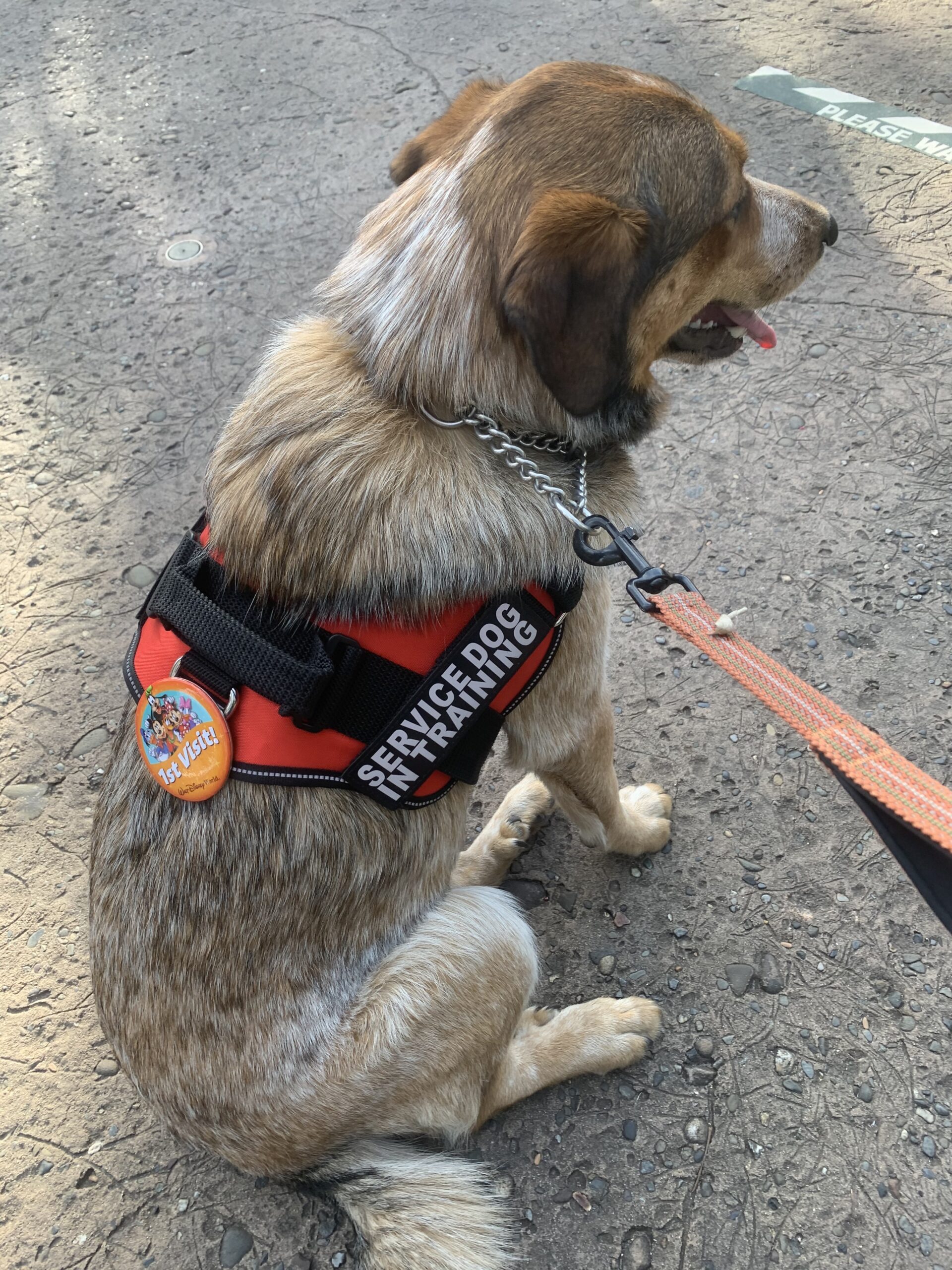
My Ace-in-the-Hole Piece of Equipment for Dog Training
I’ve saved my real treasure for last. It’s not exactly a piece of equipment for dog training but rather a convenience for anyone who keeps a dog out and about all day. In the van, we have a portable food and water dish and we use those as needed. However, we are often out with our dogs for hours on end. They eat twice a day so they don’t need food during that time but they definitely need water, and not just because we live in Florida and might spend all day out in the sun, heat, and humidity. We carry a convertible water bottle/bowl from Lesotc with us. It has a carabiner so it attaches to whatever – belt, leash, harness, treat bag. We generally carry it around empty if we know we’ll be around water sources (drinking fountains, bathrooms, free cups of water from restaurants or carts) to make it lighter to lug around. If we’re out hiking, we’ll bring it full of water (as well as bottled refills because it’s not all that big and we have multiple big dogs). Either way, once we put the water in it, it’s leak-proof. When we stop, we flip up the rubber bowl part, turn the water spout to open, and squeeze some water up into the bowl. When the dogs are done, we just let the water go back down into the bottle part and flip the bowl part back down.
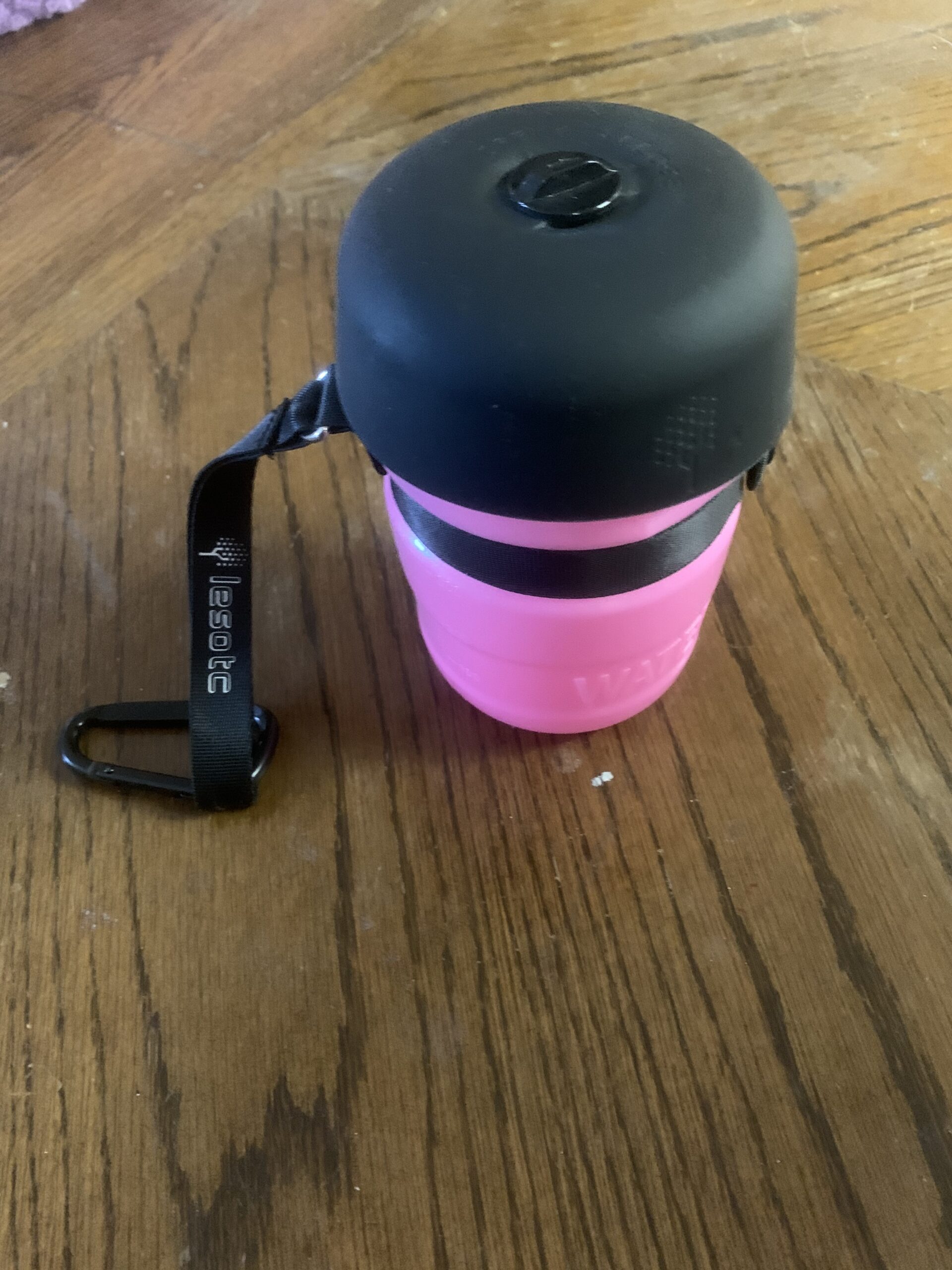

So that’s all we take out with us, even for a full day Public Access training at Disney World or a day-long excursion hiking or paddling when you really want to travel light, presuming we’re going to be home that night. We take a collar, a leash, a tiny treat bag with poopy bags, a Service Dog in Training vest, and a water bottle/bowl. “Have Service Dog, will travel.”
If you think you might want to Join Our Cause, please check out our opportunities for fostering puppies, training dogs, and donating to our nonprofit, ELLAS Animals INC, which supports a network of volunteer trainers developing rescue dogs into Service Dogs, Emotional Support Animals, and Therapy Dogs.
Nothing in ELLAS Animals INC’s website or blog is intended as medical, legal, or financial advice. We receive no compensation for recommendations or reviews.

1 comment